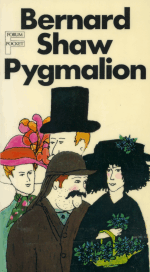
Pygmalion and Galatea; Higgins and Eliza
The play connects to the Greek myth of Pygmalion and Galatea through the characters of Higgins and Eliza. While Higgins represents Pygmalion, Eliza represents Galatea. In the myth, Pygmalion is not interested in women (as Higgins is not interested in femininity), but he comes to love the statue of a woman he has carved out of ivory. Pygmalion adorns the statue with jewels and clothes and puts great care into refining it. Higgins also takes care in refining Eliza, teaching her how to pronounce words correctly and fooling society into seeing her as a regal woman.
Although there is a possibility of romanticism between Higgins and Eliza, it is impossible for there to exist a fundamental love between them due to their diverse outlooks on life. Higgins buys a ring for Eliza, grows to depend on her for his domestic wants, and becomes adapted to her face and voice. The romantic relationship that may or may not exist between Higgins and Eliza is not important. What is signficant is Eliza's final independence and Higgins's pleasure when Eliza is no longer a "millstone" around his neck.

